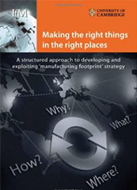Reconfiguring Global Supply Chains:
Strategy Tools for Network Design
Online course
What you will learn
Course tutors
More information
What you will learn
Course tutors
More information
Doing the right things, at the right time, in the right place
WHY ATTEND?
Manufacturing leaders today face the unprecedented challenge of reconfiguring global supply networks in a new era of harsh geo-strategic competition. Tariff impositions, regulatory pressures, and deliberate re-industrialisation policies are fracturing established supply chains and demanding strategic responses. Despite recognising these shifts, organisations struggle with making strategic manufacturing supply network footprint decisions, often addressing symptoms through tactical reactions rather than developing cohesive network strategies. This fragmented approach leaves companies vulnerable to continued disruptions, missed market opportunities, and competitive disadvantage as rivals better position their manufacturing assets for both resilience and efficiency. As manufacturing location decisions have become board-level strategic priorities, organisations need a systematic framework to transform inherited production networks into strategic assets.
OUR APPROACH
Drawing on our 25-year history of industry-leading research and successful transformations with companies such as Caterpillar, Electrolux, Grundfos, IKEA, LEGO, Philips and Rolls-Royce, the course transforms how organisations address these manufacturing supply network footprint challenges by providing:
-
-
- Strategic framework instead of tactical responses: Moving beyond short-term “continuity” responses to develop comprehensive medium-term “resilience” and long-term “strategy” approaches.
- Cross-functional alignment: Breaking down silos between operations, strategy, marketing, engineering, finance, and procurement to create a common language and unified direction.
- Data-driven decision making through objective analysis using proven assessment tools and clear KPIs.
- Prioritisation methodology to identify and systematically refine opportunities that align with strategic business imperatives for maximum impact.
- Anticipatory rather than reactive approaches by building adaptive network designs that can respond to future scenarios
- Change management excellence: Developing leadership approaches and communication strategies needed to deliver complex organisational change.
-
UPCOMING COURSES
Register interest or suggest additional dates – be notified when new dates are announced, or tell us what would be the best date range for you
We have been implementing the strategy for a couple of years and are seeing the benefits – factories in the right locations, more regional centres of expertise, a consolidation of activities and ultimately value chains which are more responsive to customer needs.
WHY ATTEND?
Manufacturing leaders today face the unprecedented challenge of reconfiguring global supply networks in a new era of harsh geo-strategic competition. Tariff impositions, regulatory pressures, and deliberate re-industrialisation policies are fracturing established supply chains and demanding strategic responses. Despite recognising these shifts, organisations struggle with making strategic manufacturing supply network footprint decisions, often addressing symptoms through tactical reactions rather than developing cohesive network strategies. This fragmented approach leaves companies vulnerable to continued disruptions, missed market opportunities, and competitive disadvantage as rivals better position their manufacturing assets for both resilience and efficiency. As manufacturing location decisions have become board-level strategic priorities, organisations need a systematic framework to transform inherited production networks into strategic assets.
OUR APPROACH
Drawing on our 25-year history of industry-leading research and successful transformations with companies such as Caterpillar, Electrolux, Grundfos, IKEA, LEGO, Philips and Rolls-Royce, the course transforms how organisations address these manufacturing supply network footprint challenges by providing:
-
-
- Strategic framework instead of tactical responses: Moving beyond short-term “continuity” responses to develop comprehensive medium-term “resilience” and long-term “strategy” approaches.
- Cross-functional alignment: Breaking down silos between operations, strategy, marketing, engineering, finance, and procurement to create a common language and unified direction.
- Data-driven decision making through objective analysis using proven assessment tools and clear KPIs.
- Prioritisation methodology to identify and systematically refine opportunities that align with strategic business imperatives for maximum impact.
- Anticipatory rather than reactive approaches by building adaptive network designs that can respond to future scenarios
- Change management excellence: Developing leadership approaches and communication strategies needed to deliver complex organisational change.
-
UPCOMING COURSES
WHAT YOU WILL LEARN FROM THIS COURSE:
- Develop a ‘North Star’ manufacturing supply network footprint that balances cost, quality, service dependability, sustainability, and growth objectives in the face of global uncertainties.
- Establish Network Design rules to guide strategic decisions: Apply a structured approach to determine what to make vs. buy, where to locate facilities, and how to configure the supply network for competitive advantage.
- Create executable transition plans: Design realistic implementation project plans that minimise disruption while achieving strategic objectives and accelerating tactical moves that align with forward scenarios.
- Achieve significant financial benefits: Companies implementing these approaches have achieved substantial cost savings.
- Build internal capability: Develop the skills needed to continuously evolve your manufacturing footprint as conditions change.
- Drive broader organisational transformation: Initiate a movement that extends beyond manufacturing to influence how your entire organisation approaches strategic decisions.
- Develop a ‘North Star’ manufacturing supply network footprint that balances cost, quality, service dependability, sustainability, and growth objectives in the face of global uncertainties.
- Establish Network Design rules to guide strategic decisions: Apply a structured approach to determine what to make vs. buy, where to locate facilities, and how to configure the supply network for competitive advantage.
- Create executable transition plans: Design realistic implementation project plans that minimise disruption while achieving strategic objectives and accelerating tactical moves that align with forward scenarios.
- Achieve significant financial benefits: Companies implementing these approaches have achieved substantial cost savings.
- Build internal capability: Develop the skills needed to continuously evolve your manufacturing footprint as conditions change.
- Drive broader organisational transformation: Initiate a movement that extends beyond manufacturing to influence how your entire organisation approaches strategic decisions.
WHO SHOULD ATTEND?
This course is ideal for senior leaders involved in strategic manufacturing decisions, including:
Key Decision-Makers:
-
- Manufacturing & Operations Directors navigating global network optimisation
- Supply Chain Executives managing the shift to regional/friend-shoring models
- Business Unit Leaders aligning manufacturing footprints with growth strategies
- CFO and Finance Directors evaluating new facility locations or major relocations
Cross functional teams: Strategy, Marketing, Finance, Engineering, and Procurement leaders who need a unified approach to manufacturing footprint decisions
Organisations facing:
-
- Active reconfiguration needs due to geopolitical tensions and tariffs
- Regulatory pressures affecting manufacturing locations
- Integration of sustainability goals into network design
- Redesigning inherited production and supply networks
- Short-, medium- and long-term manufacturing supply network footprint decisions in response to market, technological and geopolitical disruptions.
TESTIMONIALS
The training course was excellent. Despite our senior leadership team being based in locations throughout the world we were able to get together in a virtual environment, take inspiration from the research and tutors, and work and learn together to see how the approaches could work for our organisation. The IfM frameworks are now an important part of creating and refreshing our footprint strategy which shows how effective this course was.
I left the course with a great understanding of the tools which I have since applied in my role, helping to make important strategic decisions regarding long-term footprint reconfiguration. The course enabled me to make clear recommendations to senior stakeholders with confidence, knowing that they would lead to benefits in terms of ambitious growth and delivery of global synergies in cost and innovation.
REPORT – MAKING THE RIGHT THINGS IN THE RIGHT PLACES
Many of the concepts taught in this course center on manufacturing footprint strategy, an area with significant potential benefits.
Top consultants quote potential landed-cost savings of up to 45 per cent for some industries. Reducing corporate risk and gaining access to emerging markets and the best resources are equally important in securing global leverage and competitive advantage. The companies that get this right may gain leadership positions for a generation or more. Those that get it wrong are likely to fade from view or be swallowed up in ongoing consolidation.
This report describes a structured approach to understanding and exploiting a company’s international manufacturing footprint – the location of its plants around the globe, what their roles should be and how they interact with each other.
Many of the concepts taught in this course center on manufacturing footprint strategy, an area with significant potential benefits.
Top consultants quote potential landed-cost savings of up to 45 per cent for some industries. Reducing corporate risk and gaining access to emerging markets and the best resources are equally important in securing global leverage and competitive advantage. The companies that get this right may gain leadership positions for a generation or more. Those that get it wrong are likely to fade from view or be swallowed up in ongoing consolidation.
This report describes a structured approach to understanding and exploiting a company’s international manufacturing footprint – the location of its plants around the globe, what their roles should be and how they interact with each other.
COURSE TUTORS
MORE INFORMATION
Manufacturing footprint strategy
Bespoke programmes
University of Cambridge endorsement
Booking confirmation and cancellation policy
Manufacturing footprint strategy
Bespoke programmes
University of Cambridge endorsement
Booking confirmation and cancellation policy



